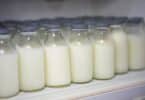The benefits of breastfeeding has been long documented, and we know that nursing our infants can boost their intelligence, increase their immunity, and reduce their chances of developing type 1 and type 2 diabetes and high cholesterol later in life. Now a new study from Dartmouth College in Hanover, New Hampshire has found that when we breastfeed our children, it can significantly reduce the risk of their exposure to arsenic.
Comparative to infants who were formula fed, the study found that breastfed infants have significantly less arsenic in their urine. Lead author of the study, Professor Kathryn Cottingham, of the Children’s Environmental Health and Disease Prevention Research Center at Dartmouth said, “This study’s results highlight that breastfeeding can reduce arsenic exposure even at the relatively low levels of arsenic typically experienced in the United States. This is an important public health benefit of breastfeeding.”
The findings of the study were published in the journal Environmental Health Perspectives. Exposure to arsenic at very high levels has been associated with gastrointestinal disorders and cancer, as well as a myriad of other diseases. Exposure to arsenic in early life has been linked to fetal death, impaired cognitive functioning and reduced birth weight. Arsenic is an element that naturally occurs and can be found in rocks, air, soil, water, plants and animals. However, the most common source of the element in humans is food, which includes some dairy and rice products, as well as water that comes from the ground.
The United States Environmental Protection Agency states that public drinking water should not contain more than 10 micrograms of arsenic. But well water is not subjected to the EPA’s regulation. Many rural areas of the United States use well water as their primary source of water. This study, as well as past studies note that even in women who live in rural areas with high arsenic levels in their drinking water, the arsenic concentrations within their breast milk were rather low, which is indicative of breastfeeding lowering the infant’s exposure to the element.
The researchers found that arsenic concentrations in infants who were only breastfed were approximately 7.5 times lower than the infants who were formula fed. The authors added, “Moreover, urinary arsenic increased with formula consumption and decreased with minutes of breastfeeding among infants who were not exclusively breastfed.”
Researchers identified the main culprit of arsenic exposure is powdered formula, stating, “Specifically, formula powder accounted for 71% of median estimated exposure in the NHBCS, suggesting that the powdered component of formula, rather than the mixing water, may be the primary source of exposure for many of the formula-fed infants in this population. Identifying the sources of arsenic in formula powder could help reduce exposure for formula-fed infants if alternatives are available in the production process, consistent with earlier calls for greater attention to contaminants in infant formula.”
The researchers also stated that the drinking water from private ground wells are also the primary source of arsenic exposure, and these families should most definitely get their tap water tested for arsenic.







